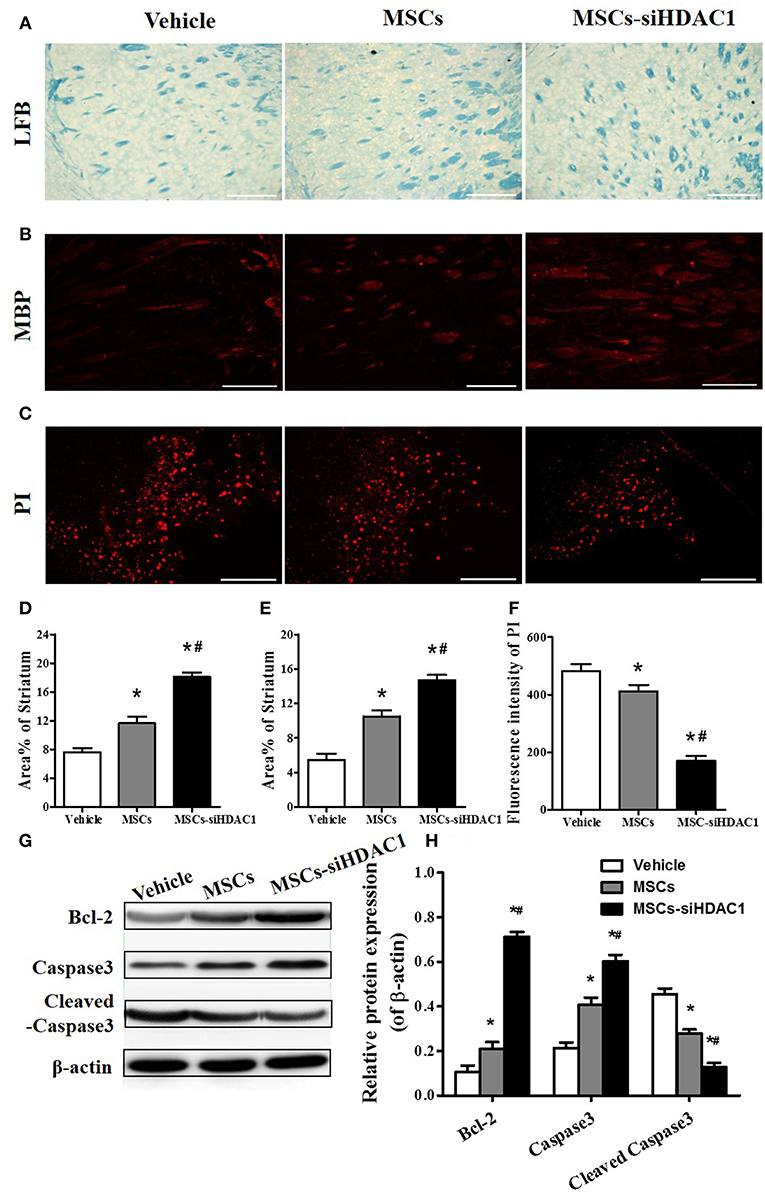
94% of researchers rate our articles as excellent or good
Learn more about the work of our research integrity team to safeguard the quality of each article we publish.
Find out more
CORRECTION article
Front. Cell. Neurosci. , 09 September 2019
Sec. Cellular Neuropathology
Volume 13 - 2019 | https://doi.org/10.3389/fncel.2019.00408
This article is a correction to:
HDAC1 Silence Promotes Neuroprotective Effects of Human Umbilical Cord-Derived Mesenchymal Stem Cells in a Mouse Model of Traumatic Brain Injury via PI3K/AKT Pathway
 Ling Xu1,2†
Ling Xu1,2† Qu Xing1†
Qu Xing1† Tuanjie Huang1
Tuanjie Huang1 Jiankang Zhou1
Jiankang Zhou1 Tengfei Liu1
Tengfei Liu1 Yuanbo Cui1,3
Yuanbo Cui1,3 Tian Cheng4
Tian Cheng4 Yaping Wang1
Yaping Wang1 Xinkui Zhou1
Xinkui Zhou1 Bo Yang4
Bo Yang4 Greta Luyuan Yang5
Greta Luyuan Yang5 Jiewen Zhang2
Jiewen Zhang2 Xingxing Zang6
Xingxing Zang6 Shanshan Ma1*
Shanshan Ma1* Fangxia Guan1,2,4*
Fangxia Guan1,2,4*by Xu, L., Xing, Q., Huang, T., Zhou, J., Liu, T., Cui, Y., et al. (2019). Front. Cell. Neurosci. 12:498. doi: 10.3389/fncel.2018.00498
In the original article, there was a mistake in Figure 5C as published. The representative propidium iodide (PI) staining photo of the MSC-siHDAC1 group is incorrect. This photo was incorrectly chosen in the process of combining the figure.

Figure 5. HDAC1-silenced MSCs alleviated white matter injury and reduced cell death after TBI. (A) Representative images of luxol fast blue (LFB) staining. Scale bars = 100 μm. (B) Myelin basic protein (MBP) staining (red). Scale bars = 200 μm. (C) Representative propidium iodide (PI) staining (red) at 3 days after TBI. Scale bars = 100 μm. (D) Average area of LFB at 28 days after TBI. (E) Average area of MBP. (F) Quantitative analysis of PI fluorescence intensity in the injured cortex. (G) Western blotting and (H) densitometry measurement of Bcl-2, Caspase 3, and Cleaved caspase 3 in the lesion boundary zone of each group at 3 days post-injury. Data are presented as mean ± SEM. *p < 0.05 vs. Vehicle, #p < 0.05 vs. MSCs.
At the same time, we also reanalyzed the fluorescence intensity of PI. And, the results showed that MSCs-siHDAC1 more significantly decreased PI fluorescence intensity than that in the original article. The corrected Figure 5 appears below.
The authors apologize for this error and state that this does not change the scientific conclusions of the article in any way. The original article has been updated.
Keywords: histone deacetylase 1, human umbilical cord derived mesenchymal stem cells, traumatic brain injury, neuroprotection, PI3K/AKT
Citation: Xu L, Xing Q, Huang T, Zhou J, Liu T, Cui Y, Cheng T, Wang Y, Zhou X, Yang B, Yang GL, Zhang J, Zang X, Ma S and Guan F (2019) Corrigendum: HDAC1 Silence Promotes Neuroprotective Effects of Human Umbilical Cord-Derived Mesenchymal Stem Cells in a Mouse Model of Traumatic Brain Injury via PI3K/AKT Pathway. Front. Cell. Neurosci. 13:408. doi: 10.3389/fncel.2019.00408
Received: 12 June 2019; Accepted: 26 August 2019;
Published: 09 September 2019.
Edited by:
Thomas Fath, Macquarie University, AustraliaReviewed by:
Vladimir Sytnyk, University of New South Wales, AustraliaCopyright © 2019 Xu, Xing, Huang, Zhou, Liu, Cui, Cheng, Wang, Zhou, Yang, Yang, Zhang, Zang, Ma and Guan. This is an open-access article distributed under the terms of the Creative Commons Attribution License (CC BY). The use, distribution or reproduction in other forums is permitted, provided the original author(s) and the copyright owner(s) are credited and that the original publication in this journal is cited, in accordance with accepted academic practice. No use, distribution or reproduction is permitted which does not comply with these terms.
*Correspondence: Shanshan Ma, bWFzaGFuc2hhbjg0QDE2My5jb20=; Fangxia Guan, Z3VhbmZhbmd4aWFAMTI2LmNvbQ==
†These authors have contributed equally to this work
Disclaimer: All claims expressed in this article are solely those of the authors and do not necessarily represent those of their affiliated organizations, or those of the publisher, the editors and the reviewers. Any product that may be evaluated in this article or claim that may be made by its manufacturer is not guaranteed or endorsed by the publisher.
Research integrity at Frontiers

Learn more about the work of our research integrity team to safeguard the quality of each article we publish.